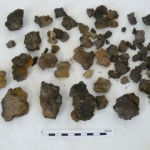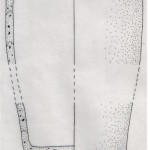The Society grant covered the laboratory costs for analysing sherds of Iron Age pottery

Iron Age pottery sherds
This project aimed to determine if there is a functionally sensitive typology of coarse native pottery from the Iron Age of South East Scotland. Cool (1982 and Broxmouth Hillfort archive) in her report on the pottery from Broxmouth proposed a typology which has since been adopted by specialists working on Iron Age pottery in South-east Scotland. Fabric and relative percentage of temper is argued here to be the most consistent typological distinguisher for the Iron Age pottery of this region. Cool has suggested that coarser Type 1 pottery was for storage, whereas finer Type 2 was better for cooking (ibid.). At Broxmouth, Type 1 is more dominant in earlier contexts, and Type 2 in later contexts (Maxwell PhD thesis in prep.). In this research project, gas chromatography-mass spectrometry (GC-MS) was employed to investigate the residues absorbed by coarse and finer Iron Age pottery from three sites in East Lothian: Broxmouth (Middle to Late Iron Age), Newmains (undated, but its assemblage is characteristic of Late Iron Age) and Traprain Law (sherds were chosen from contexts dating to the Late Iron Age (Armit et al in prep)). The grant from the Society of Antiquaries of Scotland covered the laboratory costs for analysing 9 sherds from Traprain and 15 sherds from Newmains (8 of which failed, 7 returned good results). The 18 coarseware sherds and 1 samian fragment from Broxmouth were sampled and funded by the Broxmouth Hillfort Project.
Specific aims of the project were as follows:
To investigate the function and social role of later prehistoric pottery in SE Scotland through residue analysis on a representative sample of sherds from three excavated sites, Broxmouth, Traprain Law and Newmains.
Results and Discussion
Unfortunately the residues at Broxmouth did not preserve well except in two examples, in which lipids from both plants and terrestrial animals survived. This could be due to taphonomic or storage issues, since contaminants from handling and plasticizer residues (from storage in plastic bags) were present in high quantities.

Type 2 Iron Age pottery from South East Scotland
The main finding, however, is that people at Traprain Law were using pots differently to people at Newmains. This is interesting, since during the Late Iron Age of East Lothian both of these sites are understood to be high status and Romanised, though Traprain is of course recognized as exceptional in the region. The residues from sherds from this period at both sites suggest however the exploitation of varied local subsistence economies. At Newmains both plants and terrestrial meats were consumed, whereas at Traprain few plants were consumed and frequently there is only evidence for large quantities of terrestrial meats.
Additionally, there is potential evidence for Roman imports at Newmains in the form of ricinoleic acid [castor oil], although due to a lack of comparative data this is currently difficult to contextualise. The finding of ricinoleic acid in four out of seven of the Newmains samples is of particular interest (this was not specific to a particular fabric or form of pottery), since this is the first time that ricinoleic acid has been found in prehistoric pottery residues from Britain. Ricinoleic acid is unusually abundant in castor oil, but can also be present in other plants in much lower abundance. It is also a known product of ergot. (Claviceps purpurea). Ergot is unlikely in this instance, however, due to the absence of its degradation product ergosterol despite the preservation of other alcohols, such as cholesterol, in the same samples (Seitz et al 1977, Isaksson et al 2010: 3265). Castor oil was used in antiquity as an illuminant and is found as a residue on lamps (Columbini et al 2005 and Copley et al 2005). It was also used in embalming in ancient Egypt (Tchapla et al 2004). Castor oil may also have been used as a food, for anointing (Pliny Natural History XV: 7), and for its medicinal properties for the skin and as a purgative (Pecci et al 2010). Castor oil is from a plant (Ricinus communis) which is widely grown in North Africa today, and probably also in later prehistory (ibid.: 619). Therefore this finding at Newmains potentially originated as a Roman import. However, its presence in so many of the Newmains sherds and its apparent absence across the rest of Romanised Britain urges caution; we need to bear in mind that the ricinoleic acid might, for example, derive from another processed plant which has not before been recognised in previous residue analysis studies.
Conclusion and Future Work
This research has added to our understanding of the complex and site specific biographies of pottery in the Iron Age of East Lothian. Although the findings suggest ad hoc exploitation of pottery, identities were expressed in the choice of fabric for making pots (since the choice was apparently not a functional one). The difference between coarser and finer fabrics may be indicative of restricted access to particular clay and temper resources by certain individuals or households. The residue-rich sherds from Traprain in particular suggest that pottery lived long biographies and was therefore valued. Attempts to refine a typology for the pottery of East Lothian has proven problematic, since despite differences in coarse and fine morphologies, absorbed residue signatures vary irrespective of this. Understanding developments in pottery use over time has also proved difficult, due to the lack of preservation of the Broxmouth residues. Dating of burnt food residues from the sherds from Newmains might help to further contextualise this site within the Iron Age of East Lothian and clarify the potential Roman connection in chronological terms. Further work is also needed to contextualise the ricinoleic acid in the Newmains samples through residue analysis of other assemblages, perhaps alongside experimental studies.
Raw data will form part of the Broxmouth Project archive, which will be deposited with the RCAHMS and form part of the online Canmore database. A longer report on this project presenting the sample details and their data will form part of this archive. Advice on archiving standards has been received by the Broxmouth Project from RCAHMS. This program of analysis will contribute to the Society of Antiquaries of Scotland publication on Broxmouth Hillfort (section in Armit and McKenzie in prep with the applicant as lead author). It is also anticipated that the forthcoming publication of the Traprain Law excavations will benefit from this research.
A paper on the finding of ricinoleic acid will be submitted to the journal Archaeometry, and a note published in Archaeology Scotland in order to prompt further research on this topic.
References
Alexander, D. and Watkins, T. 1998 St Germains, Tranent, East Lothian: the excavation of
Early Bronze Age remains and Iron Age enclosed and unenclosed settlements Proc Soc Antiq Scot 128: 203-254.
Armit, I and McKenzie, J. in prep. An Inherited Place: Broxmouth Hillfort.
Armit, I, Dunwell, A. and Hunter, F. forthcoming. The Hill at the Empire’s Edge: Excavations at Traprain Law, East Lothian.
Armit, I., Dunwell, A., Hunter, F., McCartney, M. and Nelis, E. 2006 Traprain Law. Current Archaeology 203: 602-607.
Clarke, D. V. 1969 New Mains, Whitekirk, Discovery Excav Scot p.24
Clarke, D. V. 1970 New Mains, Whitekirk, Discovery Excav Scot p.24
Columbini, M. P., Modugno, F. and Ribechini, E. 2005 Organic mass spectrometry in archaeology: evidence for Brassicaceae seed oil in Egyptian ceramic lamps J. Mass Spectrom. 40: 890-898.
Copley, M. S., Bland, H. A., Rose, P., Horton, M. and Evershed, R. P. 2005 Gas chromatographic, mass spectrometric and stable carbon isotopic investigations of organic residues of plant oils and animal fats employed as illuminants in archaeological lamps from Egypt. Analyst 130: 860-871.
Cool, H.E.M. 1982 The artefact record: some possibilities. In Harding, D.W. (ed.) Later Prehistoric Settlement in South-East Scotland. University of Edinburgh Department of Archaeology Occasional Paper No.8, Edinburgh, pp.92-100
Hill, P.H. 1982 Broxmouth Hillfort excavations 1977-78, an interim report. In Harding, D.W. (ed.) Later Prehistoric Settlement in South-East Scotland.University of Edinburgh Department of Archaeology Occasional Paper No.8, Edinburgh, pp.141-188
Hill, P.H. 1995 Broxmouth excavations. Draft excavation report typescript held by Historic Scotland, unpublished.
Isaksson, S., Karlsson, C. and Eriksson, T. 2010 Ergosterol (5, 7, 22-ergostatrien-3b-ol) as a potential biomarker for alcohol fermentation in lipid residues from prehistoric pottery. Journal of Archaeological Science 37: 3263-3268.
McLaren, D. and Hunter, F. 2008. New Aspects of rotary querns in Scotland. Proc Soc Antiq Scot, 138: 105-128.
Pecci, A., Salvini, L., Augenti, A. 2010 Castor Oil at Classe (Ravenna-Italy): Residue Analysis of Some Late Roman Amphorae Coming from the Port. In Late Roman Coarse Wares, Cooking Wares and Amphorae in the Mediterranean. BAR IS 2185, vol II: Oxford pp. 617-622.
Rackham, H. 1962 Natural history by Pliny, the Elder. Heinemann: London.
Rees, T and Hunter, F. 2000 ‘Archaeological excavation of a medieval structure and an assemblage of prehistoric artefacts from the summit of Traprain Law, East Lothian, 1996-7.’ Proc Soc Antiq Scot 130: 413-440.
Seitz, L. M., Mohr, H.E., Burroughs, R. and Sauer D.B. 1977 Egosterol as an Indicator of Fungal Invasion in Grains. Cereal Chem. 54(6): 1207-1217.
Stevenson, R. B. K. 1966 New Mains, Whitekirk, Discovery Excav Scot p.25
Tchapla, A., Me´janelle, P., Bleton J., and Goursaud, S. 2004 Characterisation of embalming materials of a mummy of the Ptolemaic era. Comparison with balms from mummies of different eras J. Sep. Sci. 27: 217-234.
M Maxwell, C Heron and I Armit
Help us: champion research; stimulate discussion; enhance public understanding; and share our extraordinary heritage. Donate directly to the Society now.